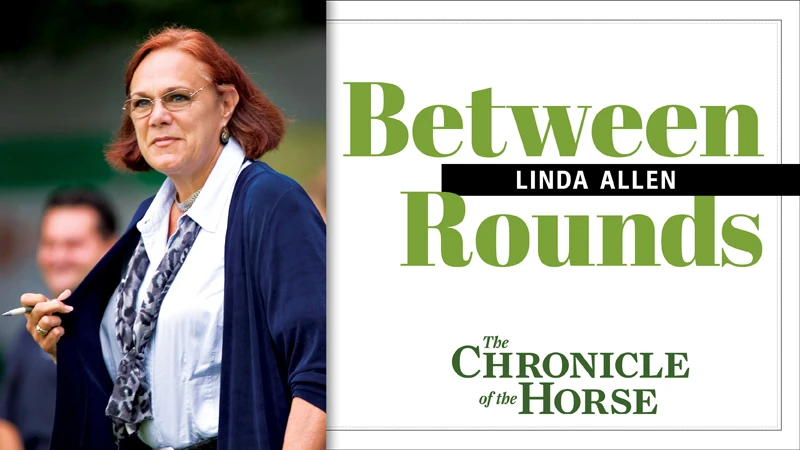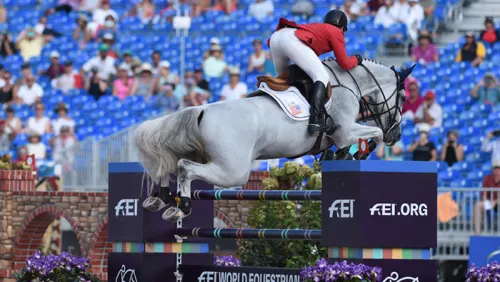Course designing has one thing in common with riding–it’s far easier to do it than it is to explain to someone else why you do it. At least people have a general idea what you mean when you say, “I ride horses.” But it’s the rare occasion when a non-horseperson understands any part of the statement, “I design courses.”
Perhaps the best explanation–at least in my case–is that I find designing just as fascinating (and just as impossible to totally master) today as I did in my early attempts nearly 40 years ago. Just as every horse and every ride is unique, every venue you work in and every course you set has its own characteristics and requirements. Boring is one adjective that doesn’t apply to this line of work!
Jumpers, hunters and equitation–each has unique parameters and objectives. Most courses are meant to be a test in some way; but hunters (and basic equitation for younger or less experienced riders) are best thought of as the setting of a stage. The designer sets a course that allows the riders to show their horses (or themselves) off to best advantage. It’s then up to the judge to evaluate what they see. Unlike jumper courses, hunter courses should never decide the outcome.
Advanced equitation courses (for medal classes or championships) are different. They must give the best-prepared riders an opportunity to demonstrate their skills, while encouraging and educating the riders who haven’t yet reached their level. And that’s the crux of the course designer’s job: education.
Back in my riding and training days, it became clear to me that, while I controlled the progress of my horses and riders at home, when we headed off to a show the course designer had far more to do with training than I did. If a particular course overmatched an inexperienced horse or rider, it took time and patience to bring them back to where they were. But if the courses were appropriate to the level of my horses and riders, and if their difficulty in-creased in a logical progression, they were far advanced when we left the show.
Evaluating the show and the section or class is the first step in designing appropriate courses. A schooling or preparatory show is far different from an A- or AA-rated show. At the former, the majority of competitors are there to train, get experience, or just have fun. These shows aren’t the place for a big grand prix or medal finals course, nor even for the hunter distances you’d find at the big circuits. Even at the largest shows, what’s perfectly appropriate for high amateur-owner jumpers might not be at all appropriate for the 6-year-old jumpers.
ADVERTISEMENT
I believe that the best course designers always try to be the trainers’ ally in getting their horses and riders going well, especially in the classes early in the week. Education is particularly important for younger and less experienced horses. I firmly believe that a major reason Europe– and particularly Germany and the Netherlands– has become the shopping mall for American buyers is that they not only raise a lot of nice horses, but they also do a superb job of educating them. Horses don’t naturally carry themselves in a good balance, respond to hand and leg aids, or understand advanced movements. Nor do they calmly enter an arena filled with brightly colored and varied obstacles and negotiate a demanding course in a businesslike manner without having had a good deal of the right kind of practice.
Europeans understand that horses just beginning their competitive careers need courses that take into account their lack of experience. For horses bred to jump, this doesn’t mean tiny jumps; but it does mean kind and inviting tracks, the sort that start out very easy and only introduce any more difficult questions near the end of the course, when their confidence is high. In Germany, 5-year-olds begin showing early in the year over the simplest “hunter-type” tracks–with jumper-sized jumps–whose on-stride lines teach the horses a rhythmic pace and en-courage a relaxed frame of mind. Only at the end of the year are they presented with more complicated single questions and very small water jumps as the last jump on the course.
The 6- and 7-year-olds have a similar structure suited to their more mature minds and reflecting what they’ve already learned. It’s no wonder that 8- and 9-year-old horses arrive on our shores ready for most anything our shows throw at them. Germany has the world’s most strenuous educational program for course designers. Every designer must complete five different levels of licensing, each including designing work at smaller competitions, apprenticing at larger events under more senior officials, and practical and written testing at their federation headquarters. Despite the rigor of their process, they require extra education and licensing to do young horse classes, an indication of the importance they place on the designers’ role in education. Designers play an essential role in producing these country’s international-quality horses and the horses they export around the world. A highlight for any American is an invitation to be the international course designer at a major competition in Europe.
Last summer I had thehonor of designing at CSIO Dublin (Ireland), and in June I was the designer for CHIO Rotterdam (the Netherlands), both Samsung Super League events. Rotterdam’s classes for 6- and 7-year-olds were particularly interesting. They were run with a “handicap”–the 6-year-olds jumped first, with the 7-year-olds following after every obstacle had been raised 10 cm. (4″), with a comparable increase in the spreads. Virtually every top rider had a horse for this division, because these are the horses they hope will be their Nations Cup horses in two or three years. It is so obvious that the “jump” is already there, but their ring experience is still lacking in comparison with the horses participating in the rest of this international event.
Long hours are no surprise to designers, and every good one I know expends even more nervous energy off the showgrounds. The longer I do this work, the more I realize how important the little details are, especially since education is just as important to me as how many made it through to the jump-off. Perhaps this is why I find it so rewarding when a rider–be it an international superstar or an amateur making their first foray into the jumper division–comes up to me to say that they appreciated the care I took for their horses. And, it’s especially nice when they say they learned a lot, had fun, and are glad that they came to the show.















